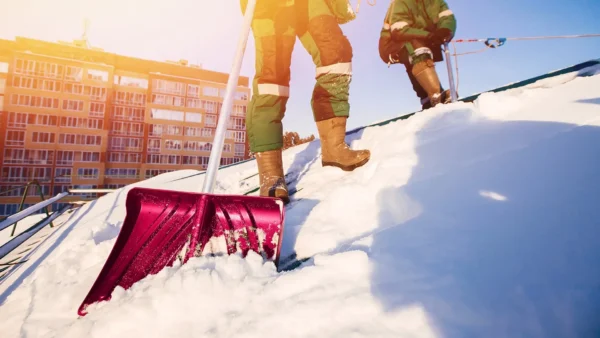Whether it’s forty degrees or forty below, your HVAC business keeps your customers cozy in Canada’s wildly varying climate. And in turn, you can rely on HVAC contractors insurance to turn down the heat on the financial risks that your business faces every day. (Yeah, it’s a bad pun, but we’ll make up for it by giving you valuable information, so please read on…)
What are those risks? Unlike plumbers, who naturally need to be concerned about water damage, HVAC technicians don’t have an obvious area of concern in terms of the insurance claims they are likely to make. We put the question to the contractors insurance experts at our business insurance partners.
They told us there are two big areas of concern for HVAC contractors: Fire losses, and losses related to freezing.
Fire losses
Fire is a problem primarily for HVAC contractors that do repair or replacement work on existing buildings, whether it be residential or commercial buildings. Because HVAC work involves using an open flame for welding, soldering or brazing, you can imagine that working in an older building that may be filled with junk and debris, can definitely lead to fires.
Freezing? Yeah, freezing
It’s not an obvious hazard, but the fact is that HVAC contractors also make quite a few claims related to frozen pipes, whether they carry water, refrigerant or other chemicals. These claims typically happen when working on new construction projects when pipes may be exposed to the elements for any number of reasons, including a failure, usually on the part of junior staff, to properly seal and insulate newly-installed pipes. If the pipes freeze and burst, it can make quite a mess.
Did you know?
You might think that you would only need to make a liability claim if you or your staff do something wrong. That would be great, but the fact is that even if you and your employees take the greatest care and do everything right (which of course, is exactly how it is), if your customer suffers, say, $30,000 in water damage, if the pipe or connection that failed is close to something you were working on, a court would probably find you at least partly liable, and that would trigger a claim. Sad but true.
Common claim scenario
You’re replacing an air conditioner in a 30-year-old house where the air conditioning unit is in the attic. The attic is incredibly dusty, there are cobwebs all over the place, and the homeowners seem to be using it as storage. There are boxes filled with the children’s old art projects. Your junior technician clears out all the boxes and vacuums the cobwebs before starting his work. Later, while brazing a connection, the oxy/acetylene torch ignites the paper backing on some insulation that had been improperly installed. The fire is put out fairly quickly, but there’s quite a bit of damage to the roof.
Total claim: $6,700
Tips for avoiding fire claims
The key to avoiding fire claims is to follow standard safety procedures for working with open flames:
- Ensure anyone working with open flame wears fire retardant clothing.
- Make sure the space is clear of debris and dust before starting open flame work.
- If flammable material is exposed anywhere near where you’ll be brazing, use metal or some other fire retardant material to shield that material from the flame.
- Only bring flammable or explosive materials (oxygen, acetylene etc.) into the space when you’re ready to braze. Remove it right away when you’re done.
- Ensure that anyone working with open flames has fire retardant blankets and a fire extinguisher close at hand.
Tips for avoiding freezing claims
- When doing HVAC work in winter, especially as part of new construction, make sure that any pipe or other components you install are not left open to the elements, even temporarily, especially overnight when temporary heating will not be running.
- When working in areas that are temporarily exposed to the cold, use heat tape and insulation as necessary to ensure pipes don’t drop to unsafe temperatures.
HVAC insurance usually includes coverage for:
- General liability (this is standard coverage that protects your business if someone sues you due to bodily injury or property damage)
- Tools and equipment (pays for repair/replacement of tools if they are stolen, destroyed or damaged)
- Installation Floater – protects air conditioners, furnaces and other components before they are installed, while in transit or at a work site awaiting installation.
Other coverage to consider:
- Business Property Insurance – This is a must if you have an office or shop. Coverage for the building, if you own it, and contents.
- Business Auto Insurance – protects vehicles owned by the business or your own personal vehicle if you use it for business purposes.
- Legal Expense Insurance – gives you unlimited legal advice and pays a portion of the legal costs if your business is involved in a lawsuit.
- Cyber and Data Breach Insurance – protects you financially if you are hacked and lose customer data or are unable to use your computer systems.
Learn more about insurance for general contractors
Safety tips from HVAC contractors
As an HVAC contractor in Ontario, your business insurance doesn’t cover injuries to you or your employees while on the job. These would be covered by WSIB.
That said, insurance claims aside, we asked experienced HVAC contractors what their main on-the-job hazards were, and what safety tips they would give to a new contractor starting out. Most of the tips were about personal safety of HVAC workers, and we thought they were worth sharing here.
Here’s some of what they said:
- Always wear your Personal Protective Equipment (PPE). That usually means:
- Steel-toed shoes when working with larger HVAC units
- Heavy-duty gloves to protect from cuts when working with sheet metal
- Appropriate masks to prevent inhaling harmful chemicals
- Safety goggles
- Long sleeves and long pants even in the summer, especially when working with refrigerant
- If refrigerant is escaping from the system, don’t try to stop it. Some of the worst injuries for HVAC contractors are refrigerant burns. This may go against your training and environmental considerations, but better to clean it up afterward than risk a bad burn.
- Always use the correct tool for the job. Sometimes you can be tempted to use whatever tools you have with you instead of going to the van for the right one. This can and has led to injuries.
- Always keep both hands free while climbing up and down ladders. Don’t try to climb up while holding something, especially something heavy.
- Use lifting and rigging equipment when possible. Just because you can lift something, doesn’t mean you should.
[Our thanks to Steve Schmelzle from RSA Insurance, one of our trusted contractors insurance partners, who agreed to share his expertise for this piece.]
Looking for contractor insurance?
Speak with a Mitch Insurance broker today to get a quote on Ontario contractor insurance. Learn more >
Call now
1-800-731-2228







